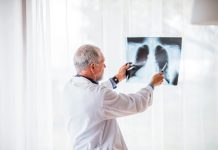
Lung cancer is often linked to smoking, but a surprising number of cases—between 15% and 20%—occur in people who’ve never smoked. Many of these individuals are relatively young, in their 40s and 50s, challenging the typical image of lung cancer patients.
Experts are increasingly concerned about the rise in lung cancer among non-smokers, pointing to radon gas as a likely culprit. Radon is a harmful gas that you can’t see, smell, or taste.
It comes from the natural breakdown of radioactive material in the ground and can enter buildings through their foundations. Once inside, it can build up to dangerous levels if not properly managed.
Despite the risk, a new survey reveals a lack of awareness and action regarding radon. Conducted by The Ohio State University Comprehensive Cancer Center, the survey found that 75% of Americans have never tested their homes for radon.
Moreover, 55% of the population isn’t worried about radon exposure in their homes, communities, or schools.
David Carbone, MD, Ph.D., a lung cancer specialist at The Ohio State University, emphasizes that lung cancer can affect anyone, not just smokers. He advocates for radon awareness and testing as critical steps to reduce the risk of lung cancer from radon exposure.
There are simple tests available to check radon levels in homes, and if high levels are found, there are effective ways to reduce them, such as improving ventilation, sealing cracks, and installing radon remediation systems.
The increasing incidence of lung cancer in non-smokers underscores the need for attention beyond the usual risk factors like smoking. Symptoms of lung cancer, such as persistent cough, chest pain, and fatigue, are the same regardless of smoking history.
Carbone urges anyone with lingering symptoms to seek medical evaluation, as early detection significantly increases the chances of successful treatment.
Currently, lung cancer screening is mainly available to those at high risk due to a long history of smoking.
However, the rise in cases among non-smokers calls for a broader discussion on screening and prevention strategies, including consideration for those exposed to secondhand smoke, radon, or certain occupational hazards.
Carbone also supports the idea of legislation requiring radon testing in homes, schools, and workplaces to help identify and mitigate this invisible danger.
The impact of radon exposure is cumulative and can take decades to manifest as lung cancer, making early testing and intervention essential.
The survey by The Ohio State University Comprehensive Cancer Center highlights a critical gap in public awareness and action on radon.
It serves as a call to action for individuals and policymakers alike to take radon seriously as a public health issue and to take steps to protect themselves and their communities from its harmful effects.
If you care about cancer, please read studies about common drugs for inflammation may help kill cancer, and statin drugs can starve cancer cells to death.
For more information about cancer, please see recent studies about the link between dairy food and certain cancers and this common food chemicals may cause cancer.
Copyright © 2024 Knowridge Science Report. All rights reserved.



